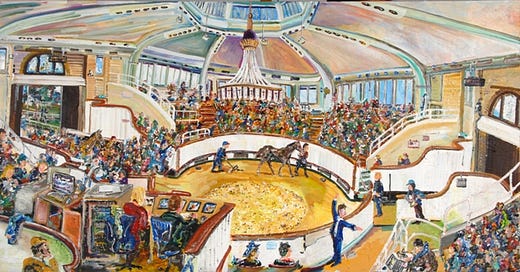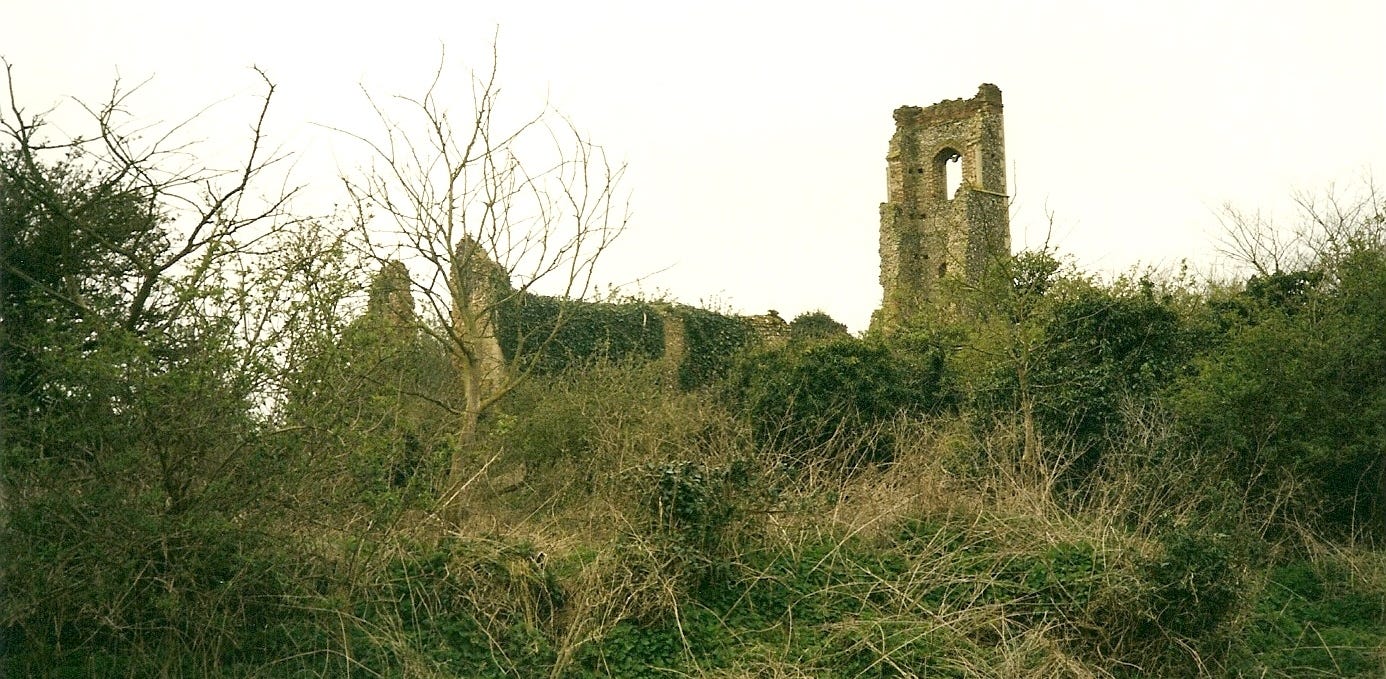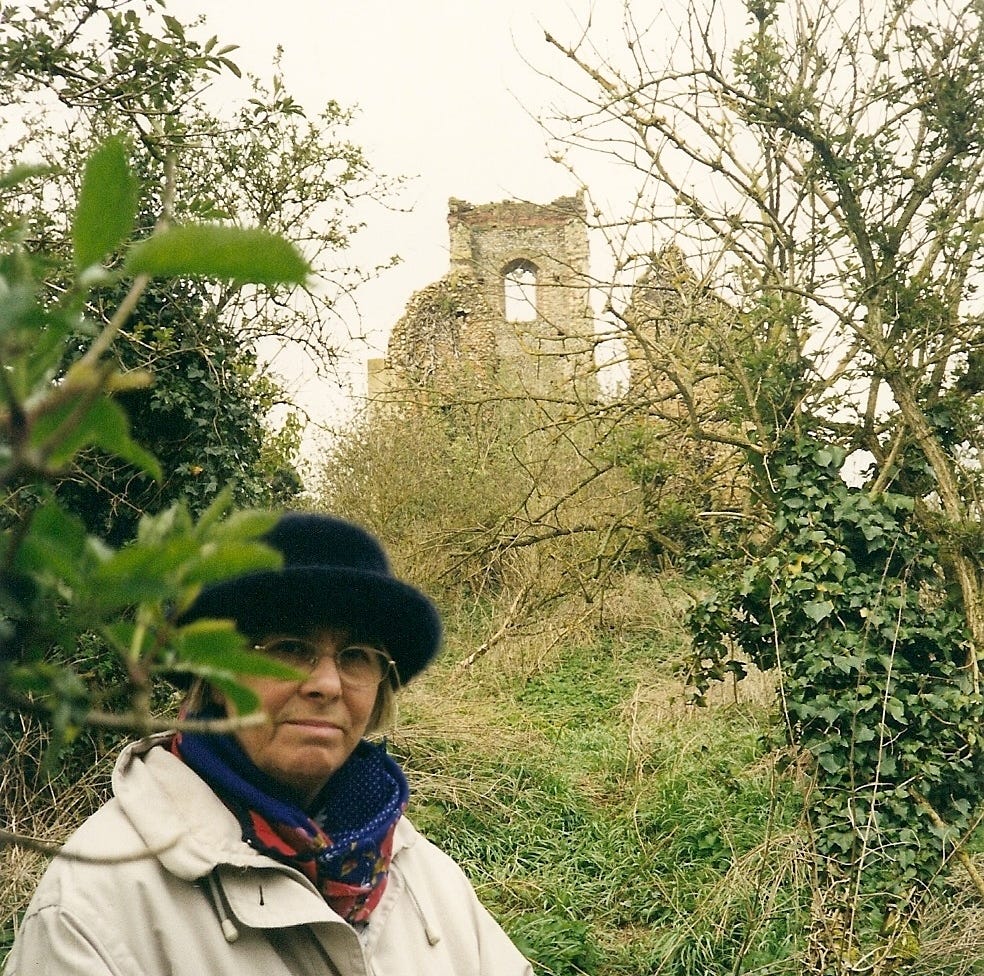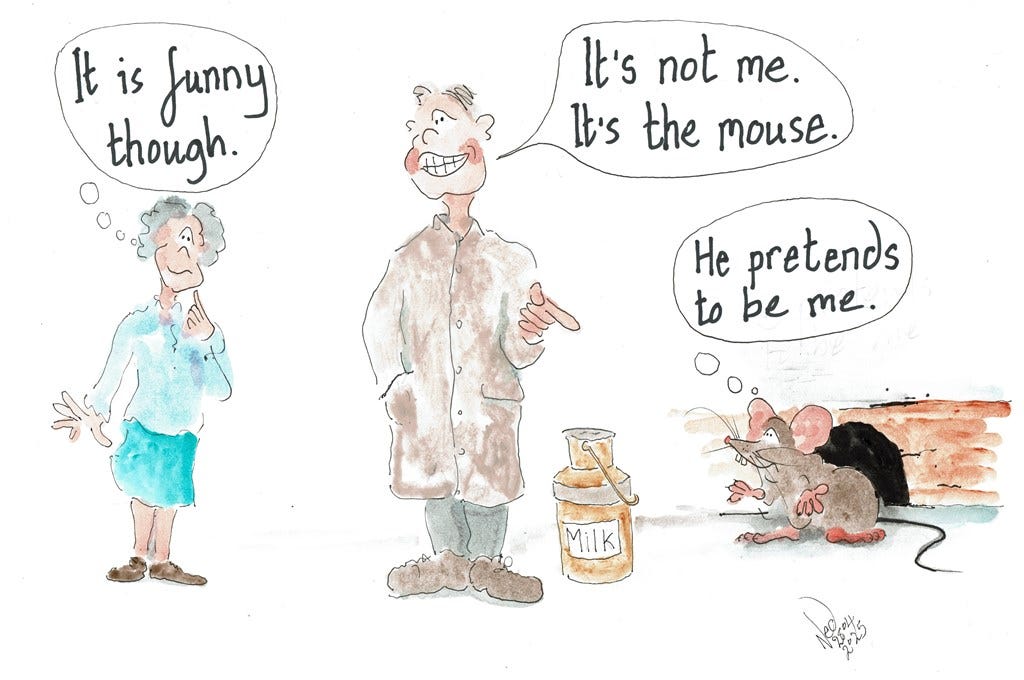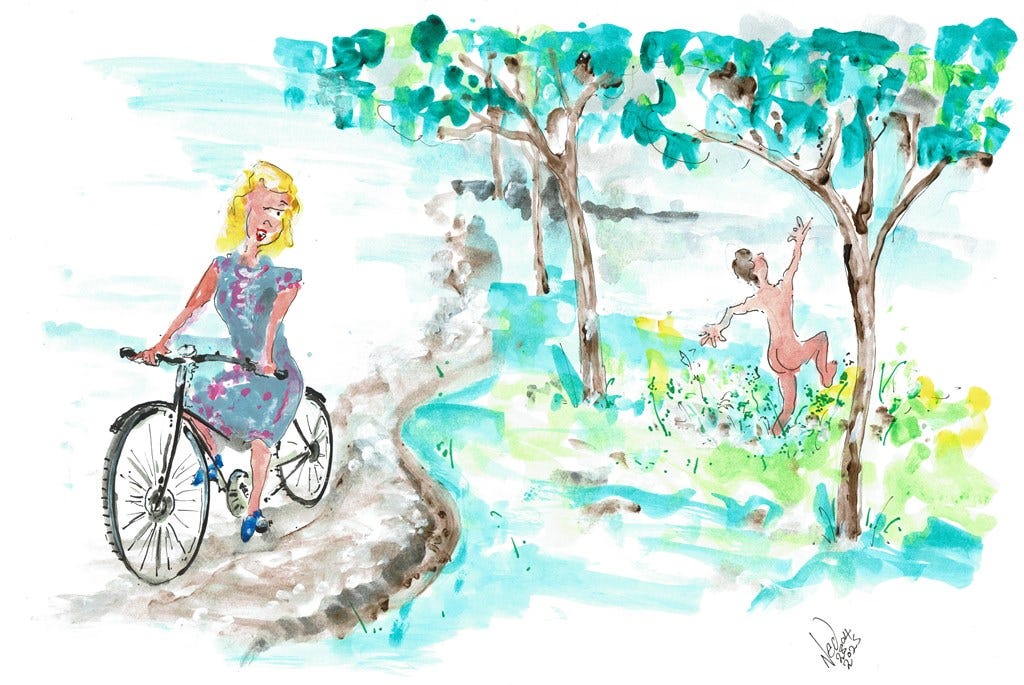Gasthorpe Tales 005
Our village shop, sugar beet, church ruins, ruined knickers, travelling salesmen, a talking mouse and dingle-dangles.
On wet mornings many workers had thick farm sacks tied around their shoulders.
Most people kept some chickens for eggs. If they had some extra to their needs, they would bring them to Mum who took note of names and numbers and put them in boxes supplied by an egg packing station at Kenninghall a few miles away. A man in a large van would come and take them away and bring little packets of money for those collected the previous weeks.
The newsagent from Hopton brought ordered newspapers to our shop for people to collect. Our shop had a bay window with a waist level shelf going right into it as an extended counter. All the papers would be put out in the bay window shelf and those who picked up first would be at the front and those expected later would have theirs put towards the back. We noticed that those who ordered the posher papers often took a sneak view of the more common ones. The newsagent also collected horse-racing bets which were also handed to Mum for him. They were wrapped in paper on which was written both the name of the punter and the horse, race and bet. The bets might be to win or each way and may involve one race or an accumulator of several. Winnings would be returned in the same way. Mum seriously studied form which as I recall involved weights, riders, previous outings, trainers, pedigree and how the ‘going’ was; for example a heavy rain could change the likelihood. I always knew better than to speak when the racing or football results came on the radio, indeed one did not move a chair or even grunt. She had a daily bet and did the pools each week. My father partook of both in a very mild way. My gran like to bet as well. When my grandmother first married she lived in Newmarket where my grandfather and his family had a coach building business. Generations later my artist son would paint live at Tattersalls in Newmarket while the thoroughbred auctions were underway. His last painting there was bought by the Duke of Bedford whose mother was selling horses from her stud.
Live At Tattersalls
78cm x 150cm Signed 27.11.2010
One afternoon when the Grand National was coming on Mum told me to ‘put the bar on’. This was an iron bar about 50mm wide and long enough to go right across the shop door. There were bolts too. I made surprise noises and she retorted, ‘I want to hear that race and they might not all be listening because some of them have no bloody culture.’
I was about 10 at the time and thought it really funny. She was referring to those in the village with no interest in horse racing who might pop in for a shop purchase. For a few minutes she did not want to be disturbed. After the race, when we had reopened and taken the bar off, someone came into the shop and said, “I came in earlier, but the door was locked.”
Mum replied, “That old door does sometimes get stuck.”
Singling
Ours was a sugar beet area. The beet was planted in rows, but in those days lots of weeds grew up as well. When the seedlings were quite small workers would go along chopping out the weeds and excess plants because if crowded they could not grow to a useful size. We children would sometimes get the job of ‘singling’. That meant you went along just behind the adult worker who would do the weeding and you would take out the extra little plants. It was quicker to work this way and we would be paid for our help. One day when I had a time limit and was wending my way home while others still worked, I had to pass a pit which was really a dry pond. It was known that people went down to pee as there was nowhere else to go. A voice called to me. I looked down into the pit. There was a man I knew, a bit, holding his willy. “Do you want to come and have a look at this?”
I certainly did not. I just walked on, slightly shaken. There were several people on the field. I never told a soul. I think I knew he was on the simple side and would get into trouble if anyone knew. It was easier to keep quiet. Also, I might not have been allowed to go singling again. I emphasise he was a well known local man, with hindsight an amusing incident, not dangerous and I was not in any way frightened.
Ruined Churches
Gasthorpe St. Nicholas Church was visible across the fields. We could reach it by walking up the farm road which was a hardened surface, but not tarred. Before getting to the farm house we took a left-hand turn up a drag way which was a used path, chiefly by farm carts and horses, but sometimes motor vehicles as it cut off three side of a rectangle. We walked uphill until reaching a ruined tower with gargoyles. Bits of some walls were standing and there were plenty of gravestones to read and play around, both hide and seek and ghosts, before making our way home. We had to be back by very set meal times. Punctuality was essential, partly because it was expected and partly because lateness led to questions as to where you had been or what you had been up to. We did but few naughty things, it was just that the adult world could find fault with the mildest of activities, so the less they knew the less they were likely to restrict.
St. Nicholas Church, Gasthorpe c.2000
Val on the St. Nicholas Church site c.2000
From British History online: Gatesthorp
http://www.british-history.ac.uk/report.aspx?compid=77113
‘Is a small village, known by travellers by the name of Gasthorp Gate, which is a publick-house that hath a gate for its sign, contrived at first, I suppose, from the name of the town; it stands on a great road which crosses the river here: it seems to take its name from some owner of it, [Gades Dorp] or Gatesthorp, signifying the village or mansion of some one of that name.
The Church is dedicated to St. Nicholas, and is a rectory, discharged of first fruits and tenths. It hath no parsonage-house, but there are 30 acres of glebe.’
Sometimes we went to Knettishall, All Saints Church. There was more of it left than the Gasthorpe St. Nicholas Church. It had an enclosed tower with steps up nearly to the top and generally more wall remained, but there were still plenty of trees and shrubs growing inside it. It was later purchased by a private owner and restored as a domestic home. My son has painted All Saints Knettishall Church in Suffolk which we’ve used as a Xmas card. The County Bridge and Gasthorpe, Norfolk, would be in the mid-left-hand background.
Jesus and St. Nick
50cm x 70cm Signed 11.11.2013
Going home from there we passed what had been the Rectory. Only a few bits of rubble were left of the building, but fruit trees of the orchard were still there and they still bore fruit if you arrived at the right time. We did.
This church was in Suffolk and we lived in Norfolk, the two being separated by The Little Ouse river. On the way home we had to cross a bridge we called The County Bridge over The Little Ouse, not as grand as The Red Arch further down the river, but good enough to climb on and under. The top part was and is made from white metal piping. We used to drop sticks in and dash to the other side to see which had won.
A few yards down the river there was a black pipe. We had been told it carried oil. It was a dare to walk across the pipe which was probably about 20cm / 8'' in diameter. I never did that, but I can remember sitting astride it and shunting myself along; that was an achievement. Before long I realised that the new pinky silk knickers I was wearing were black. The pipe was covered in some kind of tarry stuff. I was in trouble, but after all more than happy to wear ordinary knickers which I was assured I would do for evermore. I cannot imagine how I came to have the posh sort. Later the black pipe was encased in concrete and relatively easy to walk across, even pass people on, as well as a great place to sit, dangle legs while watching the water below and people who passed by on the road. Beneath that concrete covered pipe there was a shallow area in the river where we sometimes paddled and parts where one could just about swim.
Going back to the bridge and looking at the other side there was cow pasture on the right and along the river side a line of spaced out trees. My friend Joan lived the other side of the meadow at the crossroads. Joan’s father Sid had made her a swing. It was not over the river but swung beside it. We did acrobats on that swing. We had a lovely time 2 to 4 of us. Joan was a year or two older than me. She had lovely parties with cakes and sandwiches and party games organised by her mum. In their garden they had an outhouse in which their was a metal bin about a metre high and the top was well over a metre wide and not quite a metre long. It made great stage. We took it in turn to do acts singing, dancing and reciting. The only audience we had was us. We enjoyed it.
Next to Joan lived Mrs. Beevis and her husband. Mrs. Beevis sometimes made dresses for me and I expect for others. On the left, about a quarter of a mile, and going to Hopton there was a double dweller where the Footers and Murrells lived and opposite them a long, long wall built of flint and brick with a round tiled top. Behind that wall was at sometime gardens, but just a wood in my time. When I was about 11, I often walked with my dog to meet a friend who cycled to work at Hopton. One day as I wandered along there was a man on the side of the road having a pee, only he was facing me instead of backing. I ignored him and walked on to my usual meeting point with my friend. She wasn’t there, so I turned, walked back and he was still there. Soon my friend Vivien did turn up and told me there was still a man apparently having a pee on the side of the road. With hindsight, what was it with Gasthorpe and men dingling their dangles? I can only assure you, it did happen. It was not such a common occurrence, but such events do stick in the mind. There’s another similar event later on!
The Common Road
There was a tarred road from The County Bridge to the village and on either side meadows we called The Common. On each side several yards from the road there was a line of conifers which provided cones to be collected for burning should the urge to collect them arise. They were welcome as fire starters at home. The trees could also be climbed. The grass near the trees was full of little dips and slopes, probably where small pits had been made when removing chalk or sand for building or road making.
Further along into the meadow on one side there was an oak tree we always called The Climbing Tree. It was a favourite venue about quarter of a mile from the road so far enough away from prying eyes, not that we were naughty, but adults could be restricting and see danger where there was none, and if out of earshot one could not be called upon to run errands. The meadow had a dry shallow valley, the banks of which we ran up and down. Even small hills were luxuries. There were rabbits which meant holes and moles which meant mounds of the softest earth to run fingers through or if water was at hand use for mud pies. Sometimes water would gather in spots in the tiny dips in the usually dry valley. Further over on the meadows and towards the river the ground became soggy and reedy. Sometimes you could walk across the meadow to the river and sometimes it was too damp. Among the reeds one sometimes found eggs. We could walk, run, wander and wonder.
Travelling Salesmen
Several people who had shops in neighbouring villages also travelled around selling their wares and visited our village). The coalman came fortnightly. One coalman stamped his feet hard as he walked and we secretly referred to him as Stamp Tud; never to his face. He was hardly prone to conversation and I don’t think I ever exchanged words with him. This was unusual because most people said something.
Three bakers and two butchers each came round twice weekly. During WWII rationing you had to be registered with a butcher. A girl drove one baker’s van. Often on a Saturday morning she would let me ride with her and drop me off on the return near or in the village. Her round took her all morning. Grocers also came because our shop didn’t sell quite everything, for example butter. During rationing time grocers were allocated certain produce and quotas were an essential part of living. One shop keeper, an elderly man, came on his bicycle with a basket on the front carrying his goods. Milk always had to be fetched.
Milk
We walked to the farm at Knettishall to get the milk. We went in the afternoons. At the farm we were allowed to walk through the nettus, the milking parlour….
Note: My transcriber asked about ‘nettus’, searched for the definition online and found:
https://www.nealsyarddairy.co.uk/products/pyghtle-copy
Nettus is a Suffolk word that literally means 'neat house' but is commonly used for a small livestock shed on a farm. Broughton Hall Farm has a ‘nettus’ where the family’s pet chickens reside.
… and watched the cows walk into their stalls. There were rows of them. The cows knew where to go. The cowman would put a chain, quite loose, round each cow’s neck while the beast chomped at food. The udder was washed and electric suction tubes put on each teat; sometimes called a quarter. The farm had its own electricity generator. For various reasons, sometimes a cow would be hand-milked. All the milk was carried to the dairy where it would go through a cooler, then into our cans and bottles. The measures received were generous. We paid the dairyman who was the head cowman. I knew him from when I was very little because his two daughters, Ivy and Doris, used to take me for ‘walks’ in my pushchair and I spent many an hour at their house. He also had a son called Jack. His name was Billy Fitch. We called him Mr. Fitch, but when I was tiny in his house, I called him Toe Tag. He used to pretend there was a talking mouse in his house as he did his own ventriloquist act.
Note: This just described the production and consumption of raw milk. Today I have to go to Wyken Market to buy raw milk because it is illegal to buy in retail high street outlets. This is because Lord Rothschild introduced this law:
https://api.parliament.uk/historic-hansard/lords/1946/apr/10/pasteurization-of-milk
In the dairy complex there were large ‘loose boxes’ where cows went when about to calf. They were very spacious with lots and lots of straw on the floor. Calves were often with the cows. Sometimes we saw them being born. In other buildings there were meal bins, grain stores, farm carts and all sorts of tools. There were masses of places for watching, wandering, learning and hiding. I don’t think the workmen minded us being there. They certainly spoke to us and made us feel welcome. Had we ever become too boisterous only a tiny reprimand would have done the trick. But, we loved it all very much and respected the work force. We often walked home across the meadows because it was shorter than the usual road route, but that tended to be when there were at least two of us on foot.
One day when I was about 10, I had gone for milk by myself with my dog. On the way home I had left the farmyard by a couple of hundred yards and gone by the farmhouse when I saw a man standing by at the roadside by the fence. It was most unusual. He spoke to me.
‘There’s a gold bracelet over in that shed’, nodding towards an animal shelter in the meadow. ‘Come over there and I will show it to you.’
I replied, ‘You fetch it and show it to me!’
At this he walked toward me and said, ‘Let me touch you,’ where upon I screamed and ran, ran, ran off down the road with milk and dog.
After a short time Rosie on her bike caught me up. Seeing my distress she said, ‘Did he hurt you?’
I explained what had happened. She replied, ‘He tried stopping me and I said, ‘Get out of my way or I’ll hit you across the bloody skull with this milk bottle!’
I could have told him that was no idle threat.
Rosie stayed with me until we reached the village. A woman from Riddlesworth passed us on her bicycle. When I arrived home I said nothing to Mum at first and then she called to me from the shop. ‘Did you see a man on your way home from the farm?’
I briefly said what had happened. Apparently, by the time the woman on the bike had reached him he was running naked on the meadow ‘among the nettles.’
Cobbling
We could get our shoes repaired in the next village, but many families had their own shoe repair equipment which included sheets of leather and metal studs called Blakeys. We were quite lucky as Dad being a trained carpenter could cope well. Shoes would be inspected and if studs were missing there might be an enquiry as to how it had happened. One felt like saying, ‘I just live’, but kept the tongue firmly between the teeth because there were no particularly appropriate answers.
Wireless
For entertainment there was the radio which we referred to as the wireless. They worked with batteries called accumulators. A man in a van came from Thetford fortnightly, his father having been the butler at the Hall before Sid, and would take one accumulator and deliver a re-charged replacement. He would re-charge the used one before his next visit.
On the radio we listened to programmes selected by my parents. The News was essential alongside the racing and its results, the football results, Old Time Music Hall style of music, plays, Wilfred Pickles, The Huggetts and a popular music programme called the Top Twenty or something akin to that. Children’s Hour was not on the list. I can remember switching it on and Mum speeding out of the shop to switch it off saying that she had enough to think about without that rubbish in the background. I believe that Larry The Lamb was talking at the time. In later years I mentioned that I had been deprived of Children’s Hour, at which the first reaction was denial. The second was, “You had plenty of other things”, a retort which convinced me of the accuracy of my memory. It was important to be careful with ‘the juice’ of the radio because if it ran out we could not get war news. I once asked, “Do you have News in peacetime?”
“Of course we do,” replied Mum.
“But what do they talk about if there is no fighting, no rationing, no air raids and all the things they say now?”
“Oh, there’s always plenty to say,” replied Mum.
Continued at
https://gasthorpetales.substack.com/p/gasthorpe-tales-006
Gasthorpe Tales 006
Previous post:
Gasthorpe Tales 004
https://gasthorpetales.substack.com/p/gasthorpe-tales-004

